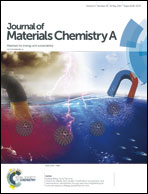An all-solid-state-supercapacitor possessing a non-aqueous gel polymer electrolyte prepared using a UV-assisted in situ polymerization strategy†
Abstract
In this work, we report the synthesis of a high ionic conducting and mechanically stable non-aqueous gel polymer electrolyte (GPE) in which a liquid electrolyte (LiClO4/propylene carbonate) is entrapped in a poly(2-hydroxy-3-phenoxy propyl acrylate) matrix by a UV assisted in situ polymerisation strategy. Unlike conventional dry and quasi-solid non-aqueous GPEs, our system (H-P-L-3M-80%) shows an excellent ionic conductivity of 4.7 × 10−3 S cm−1, a value which is comparable to those of non-aqueous liquid electrolytes. The high mechanical stability of GPE arises due to the covalent cross-links present in the polymer matrix as well as the reversible non-covalent cross-links between the solvent and the polymer matrix through the Li+ cations. Subsequently, the GPE has been prepared in situ on the inner and the outer surface of the electrode material to fabricate a 2.0 V supercapacitor device with a high mass loading (3.8 mg cm−2) of the active material (YP-80F, a high surface area porous carbon). The device shows an equivalent series resistance (ESR) as low as 2.2 Ω, which is close to that of the device fabricated from the corresponding liquid electrolyte and is far better than those of the devices evolved from conventional GPEs and dry polymer electrolytes. The mass specific capacitance of 113 F g−1 obtained at a current density of 2 mA cm−2 shows 81% retention even at a high current density of 20 mA cm−2. The scalability of the strategy is demonstrated by fabricating a large area (area = 16 cm2, loading = 4.0 mg cm−2) all-solid-state flexible-supercapacitor (H-P-L-3M-S-4.0) device which can be operated at a potential window of 2.5 V. The device was found to show a mass specific capacitance of 111 F g−1 at a current density of 1 mA cm−2 (0.25 A g−1), all the while, retaining a very low ESR of 2.2 Ω. The potential of the strategy to mimic the liquid-like electrode–electrolyte interface, augmented with the ability to tune further, opens up new horizons for energy storage devices.



 Please wait while we load your content...
Please wait while we load your content...